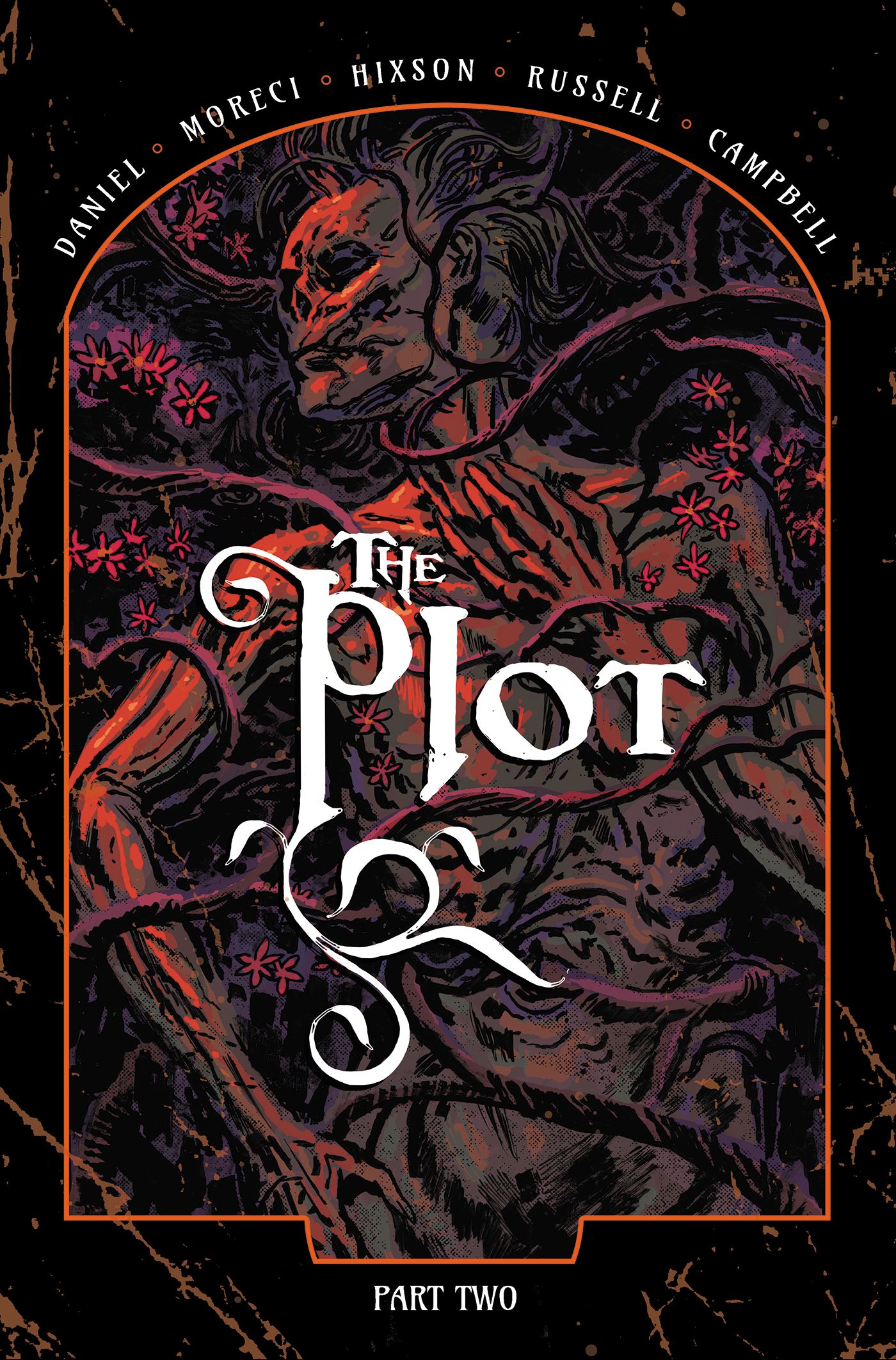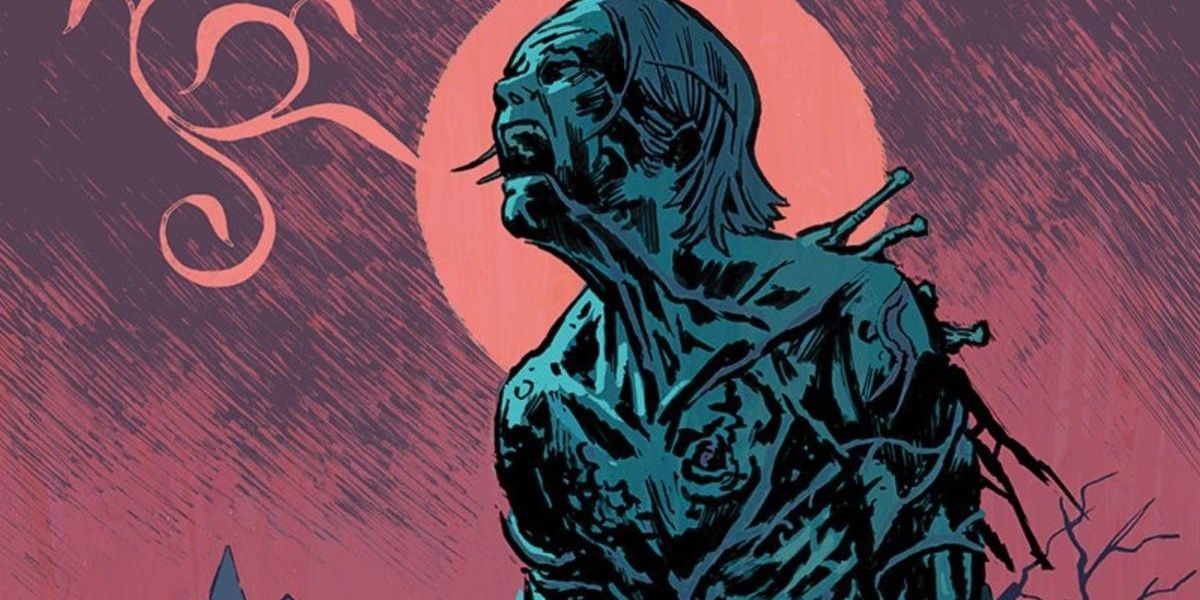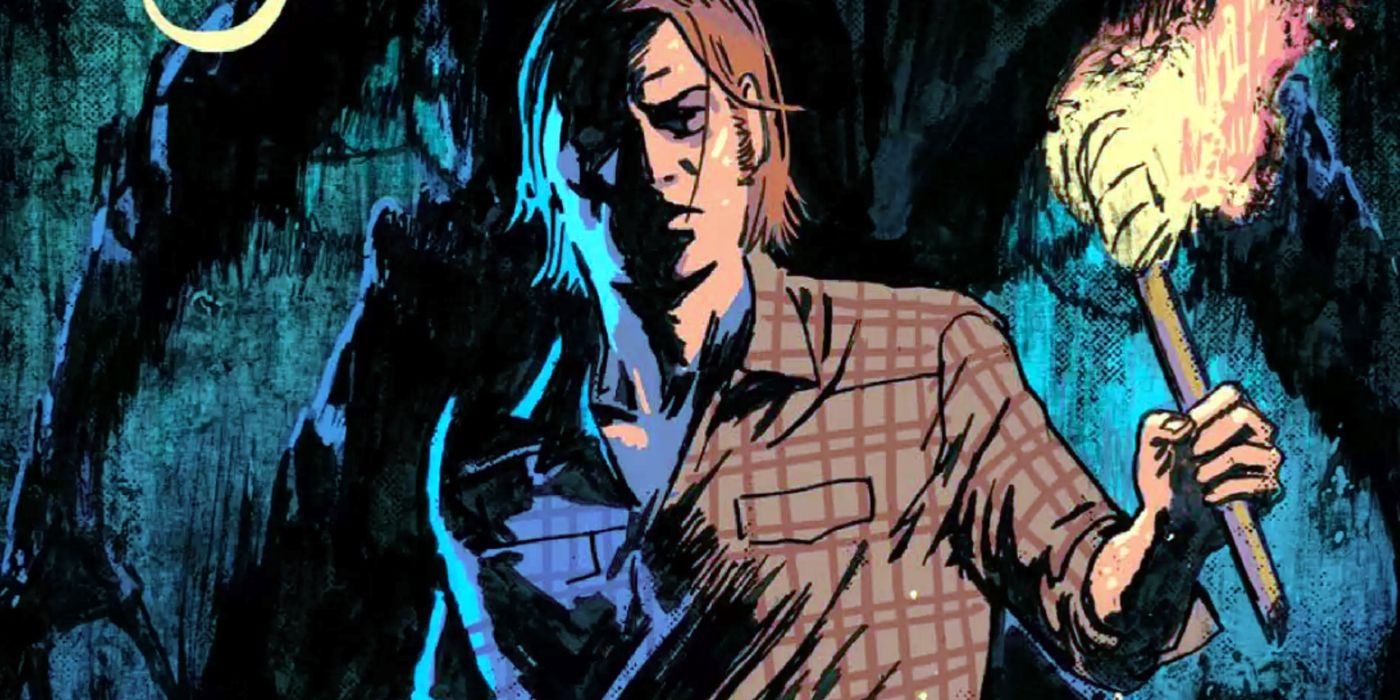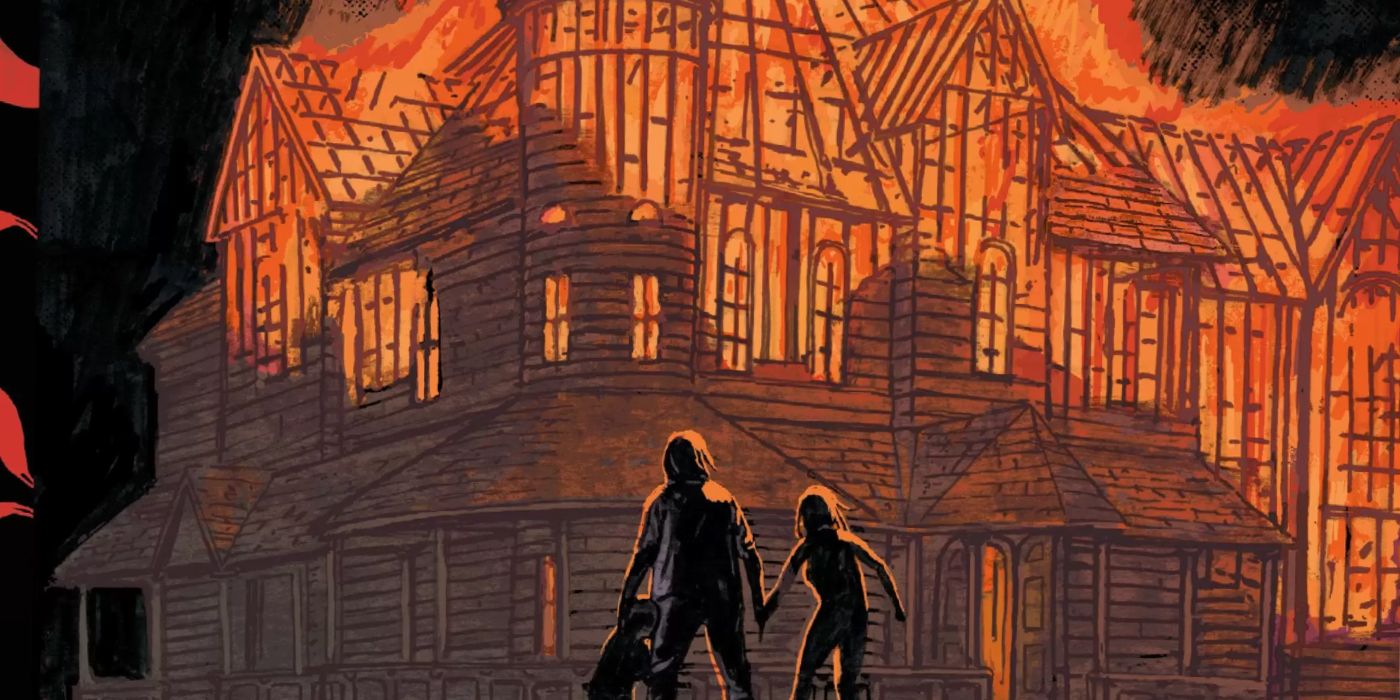Vault Comics' The Plot recently concluded with its final issue that wrapped the end of a horrifying journey for the Blaine family. The Vault series follows Chase Blaine as he has to deal with the tragic death of his brother while becoming the guardian for his niece and nephew in a series that interweaves ideas about mental illness and generational trauma with a classic monster story.
CBR spoke with the full creative team of Michael Moreci, Tim Daniel, Joshua Hixson, Kurt Michael Russell and Jim Campbell about the series as a whole to uncover what is truly waiting at the bottom of the bog, and we've got a first look at the cover for the series' upcoming second collection.
CBR: What started the journey that ended up becoming The Plot? What was that spark that got the ball rolling?
Michael Moreci: It started with Tim creating this great image of a tree made of skeletons, and from that was born this idea of a family with some deep, dark secrets. Tim and I batted that premise around for awhile - this took some time to bake - but eventually, we got these pieces together of the bog, the ancestry, the familial illness, and it all started to click in a beautiful, haunting way.
Tim Daniel: Way back in 2014, I was working on a book with Riley Rossmo that became Drumhellar for Shadowline comics. I bowed out of the project, but not before I outlined an idea involving bog bodies, which I’d discovered in a National Geographic picture gallery. Years later that idea combined with Mike’s strong desire to do a family saddled with a curse and living in a haunted ancestral home seamlessly merged together. We moved the bog to the Blaine family plot in Cape Augusta and we were off!
What was the collaborative process on the series like for the team? Was it working together or handing things off between members?
Michael Moreci: Luckily it’s Tim’s and my third go-around on something like this, so we passed stuff back and forth and were joined by Adrian Wassel, our amazing editor, who brought so much to the narrative. But, really, the MVP here is Josh. I’ll admit, our scripts were very precise and meticulous. Tim and I thought through everything down to the color cues. But Josh took even that to a whole different level with his eye for precision and his unparalleled abilities as a storyteller.
Tim Daniel: You’d think after two previous collaborations the process would get easier, but I learned otherwise. Every book is unique in process, needs, demands and requirements. Layer on top of that the last couple of tumult-filled years and navigating the creation of The Plot was a challenge. I’m genuinely proud we somehow made it and grateful to have worked with each one of these incredibly talented people. One of my fondest memories of the process was a call with Mike to walk through Issue 4. We were on fire that day, back and forth with ideas, furiously trading story beats and variations thereof and for me - the moment it really all came together is when Mike introduced Reese as this wildcard of a character - her being enthralled by the Bog Wight, being capable of doing anything at any moment. That day reminded me of the best collaboration has to offer. But to reiterate everything Mike has said here about Joshua as a storyteller, the truth is--no matter what we put into the script Josh demonstrated time and again that he was capable of crystallizing our intent with even better decisions. Every issue, Josh would provide complete thumbnails and a fully narrated audio track (sometimes w/ music) to walk us through every panel. The bottom line here is I’m greatly looking forward to the day when Josh writes, draws and colors his own book - because I’ll be buying and reading!
Joshua Hixson: It was definitely a lot of working together, although we did establish more of a rhythm more towards the end of the book that enabled us to pass the work to each other quicker. There’s not always a lot of time to go over every detail or decision together sometimes which is why I do the notes that Tim mentioned with my layouts. They put so much thought together into the writing I always wanted to be clear about what I was changing and why. That part of the process is always the most collaborative and is probably my favorite part of making comics
The Blaine family has been dealing with their monsters for hundreds of years. The monsters of The Plot are something handed down from generation to generation. How did you approach writing generational horror?
Michael Moreci: That’s the root of the story, to me. Family is so much more the genetics and the people you share a home with. It’s traditions and maladies and all the things, good and bad, that are accumulated over time and passed down, whether we want to give, and receive, or not. So, when you think about family, that’s a natural part of it. Our idea was to then dramatize that. Make all that rife with conflict and deep-seated emotion, so the burdens of family can feel like a curse.
Tim Daniel: Handing things down as you put it, is something a family does, right? Each subsequent generation is either blessed or burdened with whatever that might be. Every new generation can either adopt or discard those things that strengthen or hinder us - and we all have some degree of power in what we chose to carry with us or not. Looking back at our collaborations, the horror trilogy - at Curse and Burning Fields and now The Plot, that seems to be a strong thematic thread that Mike and I have explored, whether we were conscious of it or not. Truthfully, I don’t think we ever defeat the monsters that might plague us, we never fully escape them, but we can learn to live with them.
Did you plot out the Blaine family bloodline? Were there stories to some of the characters we see in the flashbacks in Issue 3?
Michael Moreci: To a degree. Tim’s more of the Ph.D. on the Blaine family line - he knows a lot of that lineage, more so than me. But it’d be something to explore that one day. What were the Blaines up to during, say, the Civil War? Hmmmm...
Tim Daniel: There is a family tree - we had to have some kind of guide since we’re marking time and successive generations - and it’s not just specifically focused on the Blaines; Reese’s family and the Rasmussens are intertwined. After all, her own ancestor Malthe plays a pivotal role in this series. But the histories given to those characters we see in flashbacks don’t necessarily have any greater depth to them than what was depicted on the page. The Blaine patriarchs have short life spans as dictated by the pact they made with the Bog Wight.
When creating the monster from the bog, was that a joint collaboration? What were the major influences of its design?
Tim Daniel: The National Geographic bog bodies pictorial was a real catalyst. Later I discovered a series of sculptures that were left in nature to degrade and evolve with the passage of time. I never discovered the artist’s name, but the pieces were installed beside ponds, waterways, etc. They’re all horribly beautiful. I composed a sheet of references combining pictures from both and some notes then passed it along to Josh. He delivered back several stunning iterations.
Joshua Hixson: I got a lot of references at the very beginning for the Bog Wight from Tim and Michael which made designing it pretty easy. The hardest part was figuring out how to draw it on the page. I wanted to keep it obscure and in the dark as much as I could. It was also tough to think of how it would move or stand. There was one image I did during the conceptual phase of it creeping along the ground that I really liked, but in a practical sense, it didn’t always work for it to behave that way in the book. It’s meant to be more big and imposing in most of the scenes it’s in which I also really liked to play with. Few things are scarier than a dark figure you can’t quite make out that’s just standing there staring at you.
The Blaine family motto “In order to Receive, first you must give.” hangs over everything through the series. Where did this motto come from? What do you think it means in the context of the story?
Michael Moreci: Like so much of The Plot, I honestly don’t remember who came up with that. I look at the issues and I honestly can’t tell who wrote what. But I think, in terms of meaning, it comes down to the Blaine family’s obsession with receiving. I think they’re trapped in this brutal cycle of status and familial expectations - they’re like the Kennedys of Maine, more or less - and it crushes them to try and meet them. It’s like any other cancerous cycle, where you get in so deep that you lose sight of the cycle itself, and you certainly can’t picture how you got in or how to get out. The point, in the context of the story, is to finally see the cycle, and to break it.
Tim Daniel: Just like Mike, I’m now at a loss as to where the phrase originated. It might well have been Vault EIC, Adrian Wassel! I hung a lot of thematic weight on those words though. To me, The Plot is many things, but one, in particular, is the immigrant’s tale. The idea of our families coming to America seeking The Dream. But holy hell does The Dream exact a heavy, heavy toll. That’s the evil lurking beneath the surface of it all. We all want the prize but we’ll pay with our soul, and if it can’t take our souls it simply claims our lives. Somewhere in 1674, Vitus Blaine looked that evil straight in the eye and agreed to its terms. His family and the enclave of Cape Augusta flourished. Yet whatever is down in the bog is taking their very lives in exchange.
Mental health is a theme we are introduced to in the first few pages of the series. It is clear that it is something that the Blaine family has struggled to confront for generations. By the climax of the series, it’s clear that the only way to beat this metaphorical monster is to face it head-on. Going into the finale of the series, how did you want to tie off this theme? What was your hope that the readers would take away from Chase facing something that his entire family turned away from or gave into in some cases?
Michael Moreci: For me, it’s simple: the worst monsters we’ll ever face are the monsters that live within ourselves. There’s a literal monster in this story, but Chase and the rest of his family have no chance of defeating it until they find out how to quell the monsters--anger, depression, grief, and so forth--that are plaguing them from within.
Tim Daniel: Here we are in 2021 and many people are starting to feel comfortable self-identifying who they really are, defining themselves for themselves, shrugging off labels, staring down destructive stigmas or antiquated attitudes. That takes tremendous courage and a strength most of these people have been told they don’t have, but nevertheless have possessed all along, I sure hope readers see Chase possessing similar courage and strength.
What do you think makes horror a genre that we so often see these types of themes explored in? What tools does horror allow writers and artists to use that something like action or comedy would not?
Michael Moreci: Because horror is the genre that does two things: Firstly, iIt tells the most personal stories, and secondly, because, at least in film and TV, it costs the least to make so you can take the most chances. Personally, I think horror is the quintessential storytelling genre. It’s the most flexible and the most human, yet it entertains at the same time, thrilling us with monsters and mayhem and madmen. Like I said before, we all have monsters within us, and horror is the ultimate metaphor for tackling the things we fear most--the things within our own selves.
Tim Daniel: Mike nailed it and while we might not be ready to admit it; horror is the new drama.
With Reese, a character we first meet in a hospital after being found in the middle of a road, she has long been connected to Chase from their youths. But she herself knows of the monster and the Blaine family. We even see her lettering change to a black when she is either possessed or influenced by the monster. Was she connected to it in some way because of her love for Chase?
Michael Moreci: In a way, yes. This cuts into some of the deeper mythos that, because of the space we have to deal with and the medium itself, we couldn’t really explore Reese’s total story. But, really, Reese has been poisoned by the bog. It’s why she’s drawn to it, it’s why she has that moment of darkness during the series. It’s because she’s been inside the bog--she knows something is down there, and she’s obsessed with it, consciously or otherwise.
Tim Daniel: The Blaines and Rasmussens have a history dating back to the founding of Cape Augusta and the two families first intersect through the love of Augusta Blaine and Malthe Rassmussen. Augusta’s father, Vitus Blaine denied their love through his murderous act and its equally terrible repercussions - the two families are forever bonded by the bog. Reese discovering the bog and the Wight in her teen years is no accident, as she was purposely lured in by the evil. Her becoming the emissary of that evil, being used to help shape and guide the course of Chase’s actions is definitely no accident. Their love for one another however is both genuine and an echo of history. Their love also allows Reese to put a hard fork in the road, and a fishing gaff into the Wight.
Was Reece’s possession to show that the monsters that we struggle with can affect those around us when we are doing everything we can to not face them?
Michael Moreci: Yep! Same thing with Chase’s mom, who I would have loved to explore more. And Magnus. While the family curse is deeply personal to the Blaines, the collateral damage is also a major effect of what’s born of this cursed bog.
Tim Daniel: Shared trauma is ever-present. It’s like the encroaching bog water; it’s everywhere, tainting and rotting everything, seeping into corners, dripping down upon us from overhead. You can move to another room, another house, even to another state across an entire continent, but it follows the Blaines as it follows us, until we call it out. We always said, “The house is the bog and the bog is the house” and the blight upon the Blaines and the family manor is of their own making. They invited others to share in it and those that came are now sinking into the very same morass of trauma and suffering.
One of the grand resolutions is that the Blaines must finally face their monsters head-on. Do you think this experience was the catalyst for moving past the generational family trauma that existed on that plot of land?
Tim Daniel: It’s the only way forward. The only truth, as painful as it might be. The thing I really appreciate about that is in doing so Chase is able to free his entire family as well. Again, every generation has a chance to lift up those that came before us or sink further into the proverbial bog. Chase’s actions give rise to his ancestors, literally. They rise up at last in defiance of the thing that has caused them strife for centuries. That would not happen if it were not for Zach and Mackenzie, the youngest generation of Blaines showing resolve, funneling their strength and courage into their uncle. They are the key.
The Blaine family gets to walk away from the home at the end of this story, to start anew. Do you think that it’s truly over or are these monsters something they have learned to live with by facing them?
Michael Moreci: Absolutely. I think they’ll still have strife, of course, and face hardship, sorrow, ups, downs, all the experiences of being alive. But by the end, they’re equipped to take on the task of living and have a real shot at happiness because of how they conquered their demons. A big part of this story was the Blaine family’s simple inability to function as a family. At the core is the emotional heartbreak between Chase and Charles, how they lost so much time that they could have spent enjoying one another’s lives, but instead, they were estranged, and lonesome because of it. That’s a big piece of the reconciliation, Chase finally being able to communicate with Charles; Chase being able to, quite simply, pick up the phone. It’s a small thing, but a profound one at the same time.
Through the series, you illustrated a lot of the sound effects. One that stands out is the sound that calls to Vitus Blain in Issue 5. How did you approach illustrating that? Was there a certain noise inside your head or was it inspired by something?
Joshua Hixson: Yeah I’m not sure if it was described this way in the script but I pictured a loud and otherworldly howl. Something that sounds kind of like a foghorn mixed with a bear. I’m pretty sure the spelling of it is exactly how it is in the script, it was just a matter of figuring out how it would look on the page.
The colors purple and green are highly prevalent in your issues. What made you choose those very distinctive colors that we often see when we know things aren’t right?
Kurt Michael Russell: I tried to follow Jordan Boyd, the colorist for the first four issues, and if I'm remembering correctly, he set up green as the color of the bog wight, and I tried to bring that back and reinforce those themes when the story called for it. As far as those specific colors, it's hard for me to say to be honest. That combo felt just the right amount of wrong to me.
The lettering shift for anything with the monster or those affected by it is drastic. It’s almost as if the colors are inverted, what made you make this choice in lettering those portions?
Jim Campbell: I was trying to take my cues not only from Mike and Tim’s script, Josh’s art and Jordan and Kurt’s colors but from the horror titles when I started reading US comics in my late teens (when they really started to become available in the UK).
One of the first US books I picked up was the Moore/Bisette/Totleben/Veitch Swamp Thing run, and John Costanza’s lettering was very near the front of my mind when designing the ‘base’ style for the human characters’ dialogue. As such, I wanted something inky and black, not only to evoke the newsprint feel of most of that run but to complement Josh’s great brushy swathes of ink.
With that settled, the shift to white on black, and the occasional use of transparency are very much out of keeping with the overall thinking behind the lettering… and that seemed kind of appropriate for something intruding on the ‘real’ world of the story; a voice literally coming from ‘somewhere else’. To borrow Kurt’s excellent phrase above, “just the right amount of wrong.”
The Plot is available from Vault Comics now.





